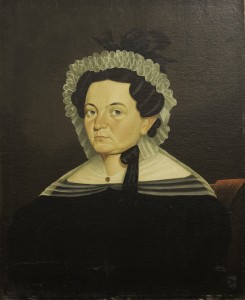For hundreds of years, artists around the world captured the likeness of subjects in a wide variety of mediums and styles from painted surfaces to sculpture to photography. In Illinois, if residents from the early 19th century wanted an image of themselves, they were limited to hiring a portrait painter. Portrait painters were both artists and businesspeople, typically traveling from commission to commission to provide an individual or family likeness. The most notable portraitist from DuPage County was painter Sheldon Peck who resided in Babcock’s Grove (Lombard after 1869) and remains nationally one of the most important portrait artists of American folk art (works done by self-taught artists). The style of these painters changed as competition with the new medium of photography gained momentum.

But what were the earliest photographers thinking about the new technology? Did they consider themselves scientists or artists? Or rather, was it about a revolution in visual communication? All of those are true and then some. Starting in the mid-1800s, photographers produced various types of prints including daguerreotypes, tintypes, and albumen prints to name a few. Each style required a working knowledge of chemistry, elements, and much trial and error in the development process. Furthermore, photographers still needed “an eye” for light and positioning much like an artist. In addition, the nature of the subject changed as well. An oil painter of the past would attempt to capture the image of a bloody battle in all its honor and glory, but photographers during the Civil War captured the actual battlefield aftermath. The death and gore seen by everyday Americans in these photos changed how people felt about the war. Photographers, like Matthew Brady, were also known to have staged scenes for their Civil War photos, not unlike painters. In any case, photography transformed visual communication in the 19th century, profoundly influencing the development of America. There were at least 18 photographers working in Naperville from the advent of photography to the early 20th century. Naperville’s most prolific photographers from the 1800s included Christian Kendig and his son, A.C. Kendig. Christian Kendig (1828-1909) was from Pennsylvania and came to Naperville in 1859. Regarded as a deeply thoughtful person by area residents, he worked as a cabinet maker, photographer, dentist, and beekeeper. He was known for his attention to detail as this ad for his photography business in the Naperville Clarion of May 1872 stated: The undersigned is prepared to furnish Photo-graphic Likenesses of unsurpassed beauty and correctness, at the most reasonable terms. Pictures taken as his establishment are warranted to be fully as good as those taken in the city. Rooms on Jefferson Avenue, Naperville, Ill. -C. Kendig As the business of photography grew in popularity and expanded through the 1880s, his son A.C. Kendig entered the business. In April 1884, A.C. Kendig’s ad printed in the Clarion invited patrons with a whimsical image of little creatures playing on his camera equipment. The ever-accommodating businessman, the ad read:
A.C. Kendig, Photographer. Continues to take all Sizes and Styles of pictures at his old stand—sunshine or cloudy weather, and aims as heretofore to please his patrons, and flatters himself to give general satisfaction, not only in artistic skill, but also in enlarging pictures and coloring in India ink at reasonable prices. Landscape vires, Houses, &c (sic), taken in town or country at short notice.
By 1898, A.C. Kendig began producing “stereopticon exhibitions” or “magic lantern shows,” which were essentially traveling slideshows of images projected on a canvas for a wider audience. These programs, designed to be both educational and entertaining, were typically offered in public spaces and included live music, live changing images on a canvas screen, and live narration with the program.
Often these images were layered as to produce a dissolved image effect. These were the early precursors to moving pictures and audiences marveled at being transported to a variety of times and places.
Kendig’s exhibition in January 1898 included a history of Naperville with images of “old settlers” and founders, street and landscape scenes from years past, and scenes from the Civil War. Undoubtedly, he was able to use the collection of images that his father had been building since the late 1850s to share on the screen. Even then, the community understood the importance and relevance of remembering history and sharing the past to help plan for the future.
Author: Jeanne Schultz Angel, Jeanne is the Associate Vice President of Naper Settlement and an Illinois Humanities Road Scholar. Jeanne is also the current President of the Illinois Association of Museums and the Coalition of State Museum Associations Foundation.

